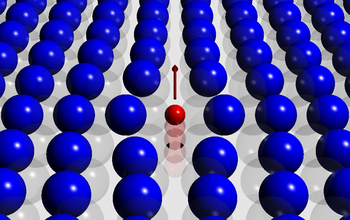Multimedia Gallery
Swimming in the Fermi sea
Graphic showing the motion of an electron through the crystal lattice of ions. On its way through the lattice, the electron repels negative ions, creating a lattice distortion that follows the electron. The electron and the lattice distortions together form a new "quasi-particle" called a polaron.
More about this image
The following write-up was written by National Science Foundation (NSF) program officer Wendell Hill in NSF's Division of Physics -- which funds the research discussed -- and was featured on NSF's public website Science, Engineering, & Education Innovation.
"Swimming in the Fermi Sea"
Our world is run by electrons. Switch on a light, browse the internet or play music on an iPod. These activities occur because electrons move through the wires, chips and headphones. But how do electrons get from one point to another? To do their job, electrons have to get through a solid -- a crystal maze of countless atoms. On their way through the solid, electrons push and pull nearby atoms, attracting positive charges and repelling negative ones.
These distortions in the crystal lattice closely follow the electron, and sometimes the electron and the lattice deformations can form a new entity or quasiparticle called a polaron. Since an electron has to drag the lattice distortions with it, the polaron is heavier than an electron moving in empty space. This means a polaron is less inclined than a bare electron to change its speed or direction if it is pulled on. Polarons are ubiquitous in solid-state materials and are responsible for electrical conduction in fullerenes and polymers.
Now, a group led by Martin Zwierlein of the Massachusetts Institute of Technology (MIT) and a member of the NSF-funded MIT-Harvard Center for Ultracold Atoms has discovered a new kind of quasiparticle in an ultracold gas of atoms -- a Fermi polaron. The polaron replaces its electron with an impurity atom that swims in a very special environment -- a "Fermi sea."
The MIT experiment validated a theoretical prediction for the energy of Fermi polarons by Frederic Chevy of the Ecole Normale Supérieure in Paris. Zwierlein's research is part of a larger effort aimed at imitating condensed matter problems using ultracold atoms as building blocks. Researchers are finding that questions that are hard to solve theoretically can be answered by Nature herself, using atoms in quantum simulators.
This research was supported in part by a grant from NSF (grant PHY 06-53514). (Date image taken: February 2009; date originally posted to NSF Multimedia Gallery: July 12, 2016)
Credit: Martin W. Zwierlein, MIT
Images and other media in the National Science Foundation Multimedia Gallery are available for use in print and electronic material by NSF employees, members of the media, university staff, teachers and the general public. All media in the gallery are intended for personal, educational and nonprofit/non-commercial use only.
Images credited to the National Science Foundation, a federal agency, are in the public domain. The images were created by employees of the United States Government as part of their official duties or prepared by contractors as "works for hire" for NSF. You may freely use NSF-credited images and, at your discretion, credit NSF with a "Courtesy: National Science Foundation" notation.
Additional information about general usage can be found in Conditions.
Also Available:
Download the high-resolution JPG version of the image. (461.3 KB)
Use your mouse to right-click (Mac users may need to Ctrl-click) the link above and choose the option that will save the file or target to your computer.



